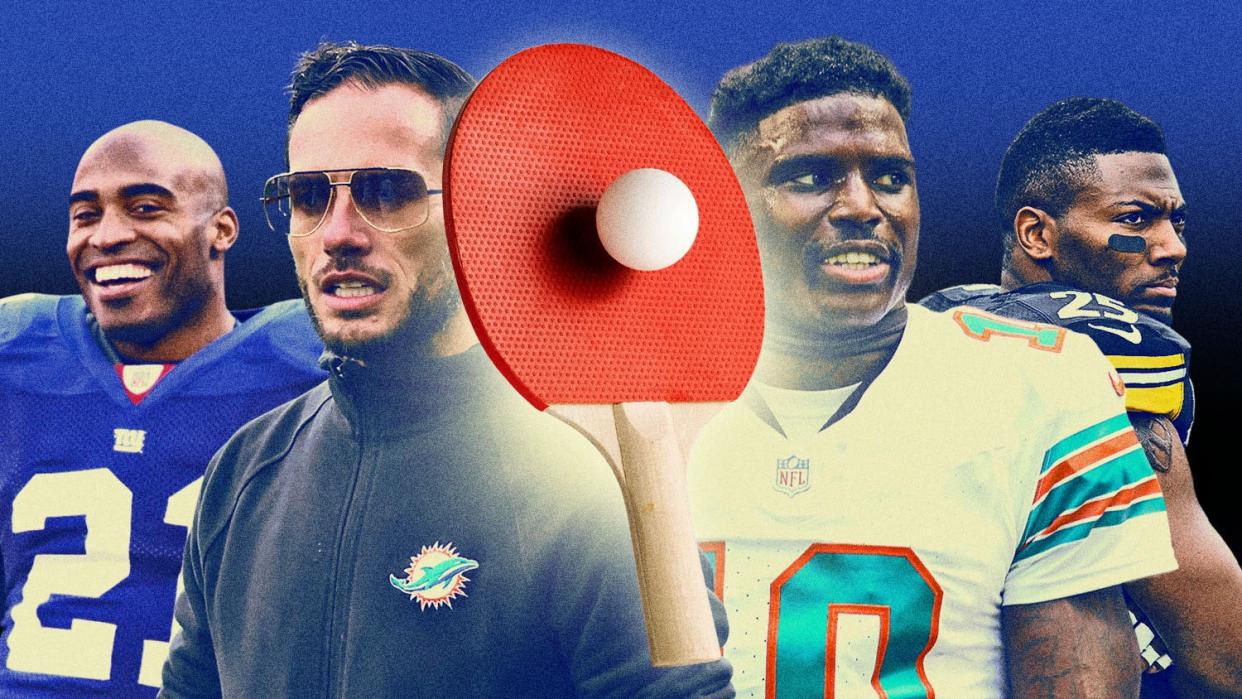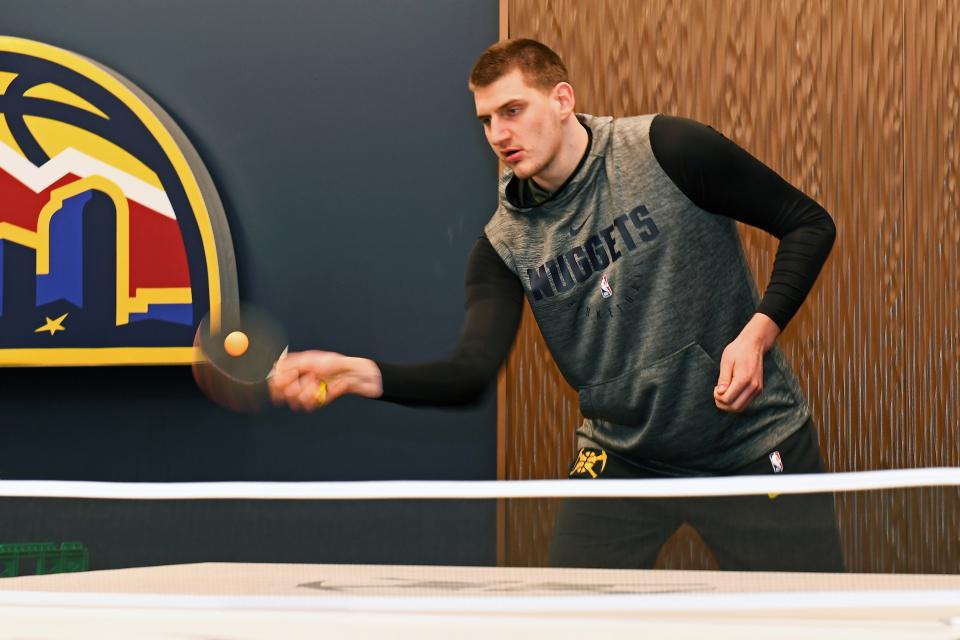Inside the NFL's Ping-Pong Wars

- Oops!Something went wrong.Please try again later.
- Oops!Something went wrong.Please try again later.
- Oops!Something went wrong.Please try again later.
Last year, newly hired Dolphins head coach Mike McDaniel began his tenure in Miami by wheeling a ping-pong table into the locker room. He followed Brian Flores, a Bill Belichick-trained disciplinarian, into the job, and he felt the table would improve camaraderie, lighten the seriousness of grueling training camp practices, and provide players with another competitive outlet. The plan initially worked: the Dolphins began the season 3-0 and teammates bonded around their new activity. But after a two-game skid, wide receiver Tyreek Hill exercised his leadership and removed the table—quietly indicating, perhaps, that the team was lacking proper focus.
“They, collectively, as a group of players, wanted more time investment during the week on their jobs for Sunday,” McDaniel said after being informed of the news. “So instead of just saying it, they did something about it.”
McDaniel, it turned out, had been a bit naive. The next day, Hill admitted to reporters that the table’s removal wasn’t a power play—he just wanted to purchase a nicer one, with Dolphins decals. But when Miami skidded again, losing five consecutive games throughout December, McDaniel didn’t wait for his captains to pull a similar stunt. With a playoff berth on the line against the Jets in Week 18, he removed the table himself ahead of practices. That Sunday, the Dolphins broke their losing spell. “[Mike] is always looking for some competitive advantage,” Miami left tackle Terron Armstead tells me. “It's definitely that sacrificial piece that coaches like to use.”
This was the latest instance of time-tested NFL trend: coaches using (or eliminating) ping-pong as an extension of their team-building philosophy. Over the last two decades, there has been no shortage of these kinds of stories: You can read about ping-pong fights in Pittsburgh, Seattle, Atlanta, Buffalo, Jacksonville, New Orleans, Tampa Bay, and Washington, to name just several. Each season, at least one new coaching staff will bring in paddles and white plastic balls (often in addition to diversions like video games, cornhole, or even golf simulators) to promote better chemistry and leisure—until or unless the team starts losing, in which case ping-pong quickly becomes the culprit for a lax approach in preparation and must be removed.
“If your team is solid, and you’ve got a handful of strong leaders in the locker room that can snap the team into focus, then you can probably get away with having some of these extracurriculars,” says former running back Tiki Barber. “But if your team is young and kind of unruly, and there's discipline issues and accountability issues, then it's just another distraction.”
In some ways, the debate is tied to the way team facilities have become cutting edge performance centers. Locker rooms are no longer cramped, smelly, dimly-lit rooms with laundry bins and spare showers. The NFL’s continued evolution into a financial behemoth has afforded most owners the opportunity to pamper their athletes with wide-open spaces (in addition to elite training rooms)—big enough, let’s say, to hold lawn games. In effect, locker room growth has created another culture decision that head coaches must consider as they assess their team’s weekly performances: glow up or declutter? “We're all individually motivated, we all want to win, for ourselves and for our teammates,” says Ryan Clark, the former 13-year safety. “But we'd be lying if we said that coaches don't pull the strings that allow us to be all we want to be.”
Steve Mariucci never used ping-pong as a coaching maneuver. During his tenure leading the 49ers and Lions throughout the late-1990s and early 2000s, Mariucci typically fostered camaraderie with one day of group activities. In San Francisco, in the midst of training camp, he took the entire team fishing. In Detroit, he hosted a golf night by the facility, where players could take target practice at a green. He didn’t even have a rookie night, which has become a standard practice in today’s NFL. “Some people like to have more fun than others and some like to keep it more business-like,” Mariucci says. “Maybe I didn't have enough fun.”
As is customary, Mariucci took his cues from the older figures in his coaching tree, which included Bill Walsh and Mike Holmgren, who preferred little nonsense. Tom Coughlin belonged to that demographic, too. Barber remembers a laissez-faire approach to the locker room under Jim Fassel, who preceded Coughlin as the Giants coach. Despite the fact that Giants Stadium was a “shithole” with miniscule training rooms and zero cold tubs, the running back took it upon himself to install a ping-pong table in a vacant storage room, hoping to inject some life into everyone’s routine. “We kind of churched it up a little bit and it became this destination, just a couple rooms away from the weight room,” he says. “[Fassel] liked it because it kept guys around.”
But on the day in 2004 that Coughlin inherited a 4-12 Giants team, removing the ping-pong table became his first priority. Barber, who had become more than proficient with the paddle, was initially frustrated. He also knew the Giants had to start fresh somewhere. “When he came in, we needed an adjustment. A serious adjustment. The culture needed to change,” Barber says. “He was essentially trying to weed out the guys who wouldn't buy in. His focus was not building camaraderie. It was like, ‘I need to figure out what my team is.’” Ultimately, veteran players couldn’t complain with his methods. “It wasn't like we were so good when we had it,” Barber laughs. A few years later, the Giants won the Super Bowl.
With more players acquiring paddle skills in college, where ping-pong tables are more prevalent, taking them away has become a riskier proposition. It’s not always easy to ban a popular toy if the vibes are right. Armstead can testify—he didn’t start playing the game until his fifth year in New Orleans, where he quickly fell in love with it. “I was awful, the worst in the locker room,” he says. “I bought a table, I practiced in my garage, and I came back the best.” Eventually, the Saints established a leaderboard, documenting various series and games that took place before and after practice. But when head coach Sean Payton wheeled out the tables and corded up the Nintendo 64 consoles before the team’s 2018 playoff game, he jeopardized breaking the habits that had led them to an 11-5 first-place record.
“When you're dealing with professional athletes, we become creatures of habit, we become creatures of routine, and the ping-pong table had become so routine for pretty much half the team,” Armstead says. The Saints had no trouble defeating the Panthers in the Wild Card round later that week, but a loss could have made Payton’s shake-up an easy scapegoat. “We griped about it—‘Oh man, this is whack,’” Armstead says. “But we were rolling.”
The players can set the tone, too. After the Steelers began the 2013 season with back-to-back losses, Clark, a defensive captain, banned anyone with less than four years of NFL experience from playing ping-pong. After two more losses, head coach Mike Tomlin then banned extracurriculars for the entire team. Pittsburgh won eight of its next 12 games, but missed the playoffs. “Your thought process is: Let's redirect where we are spending energy throughout the day,” Clark says. “Maybe that's an opportunity to do more film study, maybe that's an opportunity to get an extra workout, to get in the treatment room…Losing sucks so bad you legitimately don't want people to have fun at any other time.”
Is there a purpose for the tables beyond fun and camaraderie? Bills head coach Sean McDermott has praised the hand-eye coordination skills that ping-pong can promote, and Barber believes it can help develop anticipation. But depending on how competitive the games get, there is always the potential for injury. Mariucci’s only time playing ping-pong with players came after a 49ers training camp practice at Sierra College, where he took on hulking offensive lineman Kevin Gogan. Mariucci quickly made the mistake of beating his 6-foot-7, 325-pound opponent. “He threw his ping-pong paddle, it doinked off the table, and flew into the wall and guys were scattering,” Mariucci says.
Matt Rhule, who has shuttled between the college and pro ranks as a head coach, has never had any concerns joining his players in competition. With the Carolina Panthers and now the University of Nebraska, he sees ping-pong as a necessary locker room tool, but he mostly champions it as a form of mindfulness. “We're constantly at a war for attention in today's society, and I think ping-pong, when you do it at the right time and right place, helps guys build their attention, not detract from it,” Rhule says. “It’s a rare opportunity to be locked into the moment and sharing the moment with someone they might not otherwise.”
Though Rhule’s two seasons in Carolina ended with an overall 11-27 record, the head coach never felt like he needed to make wholesale furniture changes to send a message or reverse the team’s course. “I certainly wouldn't want my quarterback playing ping-pong right before he went out at halftime,” Rhule admits, but throughout his time at Nebraska, he says, “we've engrained ping-pong into our day-to-day routine, that to take it away would probably be more of a detriment.” As he later points out, however, “everything is a gut feel.”

San Antonio Spurs v Denver Nuggets
“We've got to remind ourselves,” Mariucci says. “Most of these players are under 26 years old, most of them are single, and so they like to have fun and get the pressure of this big business off their minds for 10 minutes.”
A couple weeks ago, you could still hear the remnants of Rhule’s influence in Carolina, when tight end Hayden Hurst stood by his locker diagnosing his team’s winless struggles. As he spoke, the sound of plastic balls bounced back-and-forth, stoking frustration from fans online unhappy with the optics—or in this case, the audio. But a couple weeks later, the same kind of optics gave Raiders fans a burst of joy. After Las Vegas fired head coach Josh McDaniels (in addition to its general manager and offensive coordinator), the team’s locker room quickly turned into a lively and relaxed clubhouse—no thanks to basketball hoops and cornhole that had been swiftly brought in.
Almost too knowingly, wide receiver Davante Adams, in the middle of a 1-on-1 session with a teammate, mimicked onlooking media for the way they might spin this new infusion of fun. “This is why they’re losing, they’re worried about the wrong shit. They’re in the locker room playing basketball,” he said jokingly, before draining a jumper. Had the Raiders’ woes suddenly been solved by a basketball hoop? A few days later, the team defeated the Giants and smoked cigars to celebrate interim head coach Antonio Pierce’s victorious debut. As Adams later told reporters, “It’s just been feeling like work too much, and not having enough fun.”
The debate will ping and pong forever, just as the table will always be a barometer for winning and losing. But Barber believes the deciding factor will always be based on a team’s buy-in to its coach’s beliefs and decisions. “There is no correlation or causation,” he says of ping-pong tables. “Whether you have one or you don't, you're both right.”
Originally Appeared on GQ

